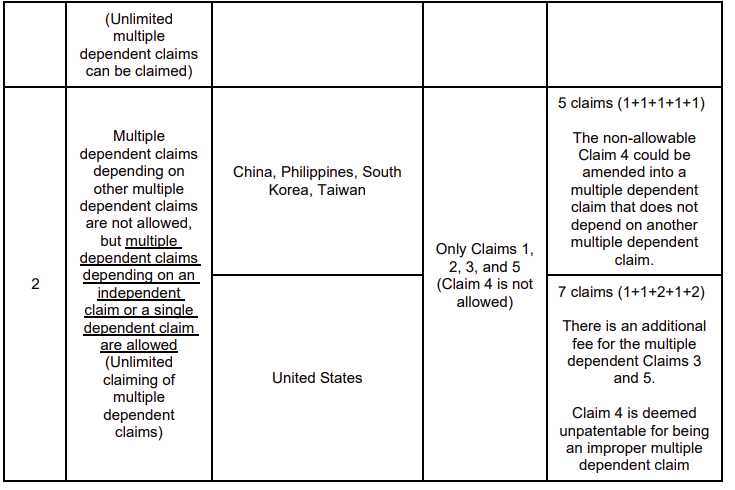The protection scope of a patent is determined by the limitations recited in its claims. There are two types of patent claims; independent claims and dependent claims. An independent claim is a standalone claim that contains all the limitations necessary to define an invention, whereas a dependent claim depends on preceding claims and adds further limitations to features already recited. A dependent claim can also be a single dependent claim, which depends on a single preceding claim, or a multiple dependent claim, which depends on two or more preceding claims. While most countries allow multiple dependent claims, many do not allow multiple dependent claims to depend on other multiple dependent claims, as this may result in complex permutations of claim scopes. However, the scopes of patents resulting from multiple dependencies is not the purview of this article, and instead, the cost factor relating to the application of multiple dependent claims will be examined.
For this purpose, the following “Patent Claims for a Chair” example will be used:
Claim 1 (An independent claim)
A chair comprising:
a base plate,
a plurality of legs that are spaced apart from each other and attached to the base plate below, and
a back plate attached to the base plate above.
Claim 2 (A dependent claim)
The chair of Claim 1 further comprising a cushion attached to the back plate.
Claim 3 (A dependent claim and A multiple dependent claim)
The chair of Claim 1 or 2, wherein the back plate is made of wood.
Claim 4 (A dependent claim and A multiple dependent claim depending on Another multiple dependent claim)
The chair of any one of Claims 1 to 3, wherein the back plate is obliquely attached to the base plate.
Claim 5 (A dependent claim)
The chair of Claim 3, wherein an arm rest is attached to both sides of the base plate
The below countries have different rules for calculating official fees for multiple dependent claims:

In contrast, in countries that only allow a limited multiple dependent claims to be claimed, but calculate official fees based on the actual number of claims, such as Korea and China, to reduce the number of claims, it is preferable to draft multiple dependent claims only to the extent that they do not depend on other multiple dependent claims. If so, a significant amount of official fees can be reduced over the entire life of the patent. In addition, single dependent claims can be amended to multiple dependent claims even after a grant of a patent provided that the single dependent claims contain all the limitations of the previous claims they seek to depend on. In detail, in the “Patent Claims for a Chair” example, the applicant would initially be charged an official fee for the total five (5) claims. However, Claim 4 would be rejected by the Korean Intellectual Property Office as an improper claim for depending on another multiple dependent claim. If the applicant amended it to a proper multiple dependent claim, then it would be regarded as one claim. Hence, in the end, the same official fee for five claims would be charged in total.
With respect to the United States, a multiple dependent claim fee of US$ 860 is charged for large entities if a non-provisional application contains a proper multiple dependent claim. In addition, there is an excess claim fee of US$ 100 per excess claim if the total number of claims is more than twenty (20) (37 CFR 1.75(c)). Accordingly, if a non-provisional U.S. patent application were to be filed with the “Patent Claims for a Chair” example, the official fees would be calculated based on a total of seven (7) claims (1+1+2+1+2), not five (5). That is, as Claim 3 depends on two claims, i.e., Claim 1 or Claim 2, it would be counted as two claims. Meanwhile, although Claim 4 would be deemed as an improper multiple dependent claim for depending on another multiple dependent claim, it would still be counted as one claim at the time of filing, but would not be charged the multiple dependent claim fee. Lastly, Claim 5, which depends on Claim 3, would be calculated as two claims, for as mentioned above, Claim 3 depends on Claim 1 or 2. Should the applicant decide to amend Claim 4, it could be amended to a proper single dependent claim but should be careful to includes all the limitations of a preceding claim to ensure its future enforceability (4th Para., 35 U.S.C. 112). For these reasons, when filing an application to the United States Patent & Trademark Office, it is recommended that a claim set be filed with only independent claims and single dependent claims, but not multiple dependent claims.
Finally, for a PCT international application, there are no additional fees for claiming limited or unlimited multiple dependent claims. Further, the cost of filing a PCT international application does not depend on the number of claims. However, if an applicant plans to enter the national or regional phase of Japan, Europe, Korea, China, or the U.S., it is recommended that claims be drafted using an unlimited multiple dependent claim format, and that a voluntary amendment be submitted at the time of a national phase entry in countries where unlimited multiple dependent claims are not allowed, e.g., U.S., Korea, and China. This is important, for in some countries, a voluntary amendment that increases the number of claims by undoing multiple dependencies after an office action is issued may not be allowed on the grounds that it constitutes adding new matter.
There are many factors to consider when drafting claims, however, by understanding the different types of claims that can be used, as well as the nature of fee calculations that differ by country, patent filing costs can be significantly reduced.




